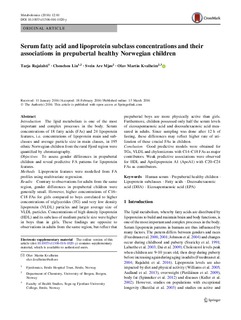| dc.contributor.author | Rajalahti, Tarja | |
| dc.contributor.author | Lin, Chenchen | |
| dc.contributor.author | Mjøs, Svein Are | |
| dc.contributor.author | Kvalheim, Olav Martin | |
| dc.date.accessioned | 2016-12-22T13:31:11Z | |
| dc.date.available | 2016-12-22T13:31:11Z | |
| dc.date.created | 2016-07-11T11:01:36Z | |
| dc.date.issued | 2016 | |
| dc.identifier.citation | Metabolomics, 12(81). doi: http://dx.doi.org10.1007/s11306-016-1020-y | nb_NO |
| dc.identifier.issn | 1573-3882 | |
| dc.identifier.uri | http://hdl.handle.net/11250/2425790 | |
| dc.description.abstract | Introduction
The lipid metabolism is one of the most important and complex processes in the body. Serum concentrations of 18 fatty acids (FAs) and 24 lipoprotein features, i.e. concentrations of lipoprotein main and subclasses and average particle size in main classes, in 195 ethnic Norwegian children from the rural Fjord region were quantified by chromatography.
Objectives
To assess gender differences in prepubertal children and reveal predictive FA patterns for lipoprotein features.
Methods
Lipoprotein features were modelled from FA profiles using multivariate regression.
Results
Contrary to observations for adults from the same region, gender differences in prepubertal children were generally small. However, higher concentrations of C16–C18 FAs for girls compared to boys correlated to higher concentrations of triglycerides (TG) and very low density lipoprotein (VLDL) particles and larger average size of VLDL particles. Concentrations of high density lipoprotein (HDL) and its subclass of medium particle size were higher in boys than in girls. These findings are opposite to observations in adults from the same region, but reflect that prepubertal boys are more physically active than girls. Furthermore, children possessed only half the serum levels of eicosapentaenoic acid and docosahexaenoic acid measured in adults. Since sampling was done after 12 h of fasting, these differences may reflect higher rate of utilization of these crucial FAs in children.
Conclusion
Good predictive models were obtained for TGs, VLDL and chylomicrons with C14–C18 FAs as major contributors. Weak predictive associations were observed for HDL and Apolipoprotein A1 (ApoA1) with C20–C24 FAs as contributors. | nb_NO |
| dc.language.iso | eng | nb_NO |
| dc.publisher | Springer | nb_NO |
| dc.rights | Navngivelse 4.0 Internasjonal | * |
| dc.rights.uri | http://creativecommons.org/licenses/by/4.0/deed.no | * |
| dc.subject | Human serum | nb_NO |
| dc.subject | Prepubertal healthy children | nb_NO |
| dc.subject | Lipoprotein subclasses | nb_NO |
| dc.subject | Fatty acids | nb_NO |
| dc.subject | Docosahexaenoic acid (DHA) | nb_NO |
| dc.subject | Eicosapentaenoic acid (EPA) | nb_NO |
| dc.title | Serum fatty acid and lipoprotein subclass concentrations and their associations in prepubertal healthy Norwegian children | nb_NO |
| dc.type | Journal article | nb_NO |
| dc.type | Peer reviewed | nb_NO |
| dc.source.volume | 12 | nb_NO |
| dc.source.journal | Metabolomics | nb_NO |
| dc.source.issue | 81 | nb_NO |
| dc.identifier.doi | 10.1007/s11306-016-1020-y | |
| dc.identifier.cristin | 1367363 | |
| cristin.unitcode | 216,10,0,0 | |
| cristin.unitname | Avdeling for helsefag | |
| cristin.ispublished | true | |
| cristin.fulltext | original | |
| cristin.qualitycode | 1 | |

